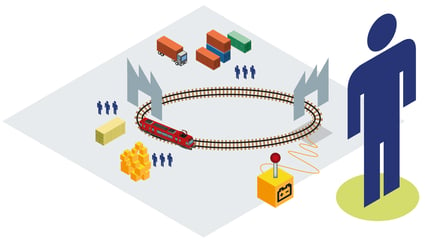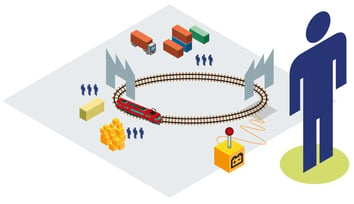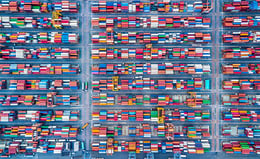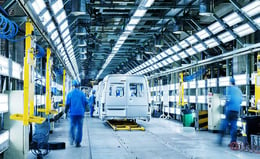5 Reasons Why You Should Simulate Your Factory
Brian Hoey - October 31, 2019

 In the past few years, the industrial world has seen an increase in the use of so-called digital twins, i.e. digital representations of physical factories. Maybe you’ve heard about technology that makes use of this concept—maybe you’ve even wondered why and how this concept could theoretically be applied to your own operations. If you have, then you’ve come to the right blog. Today, we’ll give a quick rundown of the top 5 uses for factory simulations, and how those uses can drive value and reduce disruptions for modern manufacturers.
In the past few years, the industrial world has seen an increase in the use of so-called digital twins, i.e. digital representations of physical factories. Maybe you’ve heard about technology that makes use of this concept—maybe you’ve even wondered why and how this concept could theoretically be applied to your own operations. If you have, then you’ve come to the right blog. Today, we’ll give a quick rundown of the top 5 uses for factory simulations, and how those uses can drive value and reduce disruptions for modern manufacturers.
1. To Predict the Impacts of Proposed Changes
Perhaps the most obvious reason to simulate a factory is to understand in advance the ways that different decisions might affect factory floor operations. If, for instance, you’re wondering whether you might improve your throughput by changing the arrangement of a few machines or stations, running a simulation of those proposed changes is going to be much faster and cheaper than actually trying out the changes in physical space and measuring the results. The trick here is that in order for this kind of digital cost and throughput comparison to be useful, your simulation needs to be equipped with a fairly granular level of detail. Everything from the layout of the factory to the maximum uptime of each station to the location of relevant bottlenecks in the movement of raw goods from your warehouses to the factory floor to each respective station needs to be mapped out in digital space as closely as possible. Doing so will require a decently high degree of starting visibility to accomplish, but it will also pave the way for improvements to visibility in the long rung.
2. To Uncover Inefficiencies
Okay, now let’s say you aren’t actively proposing any new changes to your production chain. Instead, you just have a sneaking suspicion that your throughput isn’t as high as it could be, or your makespan could be shortened slightly, or your products could me made in a less resource-intensive way. By training an advanced prescriptive analytics workflow on your digital twin, you can take that hunch or gut feeling and potentially turn it into real value. How? By simulating your factory floor operations in such a way as to give your advanced analytics a chance to pinpoint potential areas of waste and inefficiency. These workflows can start from your existing configuration of elements and produce potential areas where you could either add value or reduce the likelihood of disruptions through various changes and adjustments. This might be something as simple as loading up forklifts in a different part of the factory, or as complex as rearranging your job shop—but in either case it should present you with the opportunity to better fulfill incoming orders in a resource-efficient way.
3. To Improve Visibility
We mentioned visibility briefly above, but let’s dig a little deeper into exactly how a digital twin can help different touchpoints on the value chain gain cohesion and insight into one another’s processes. Though physical production facilities are at the heart of every other element of a given manufacturing operation, they can also be fundamentally opaque for those who aren’t directly interacting with the factory floor on a daily basis. As a result, businesses often wind up in situations where sales people are committing to orders that can’t actually be fulfilled under current conditions or logistics managers are making decisions about moving goods around the supply chain that are odds with the actual needs of plant managers. In addition to being useful platforms for analytics integration, digital twins can also help to prevent the kinds of disconnect we just outlined. A salesperson with access to a digital version of the relevant production plant will be able to get insight into things like makespan and throughput that will help them calibrate their expectations to what’s really possible within the current production model. By the same token, stakeholders outside the immediate production planning unit will be able to gain some insight into how any proposed decisions might impact factory floor operations, helping teams to avoid working at cross-purposes.
4. To Offer Real-time Monitoring
Once you’ve leveraged digital technology into improved visibility, you can take things a step further by integrating real-time data monitoring into your digital twins. This will mean leveraging internet of things (IoT) devices and RFID chips at strategic positions through the factory to power data streams that reflect minute-to-minute changes in conditions—with the result being an IT environment that’s built to increase agility. With real-time integration, planners at every touchpoint on the value chain can get an instantaneous snapshot of production operations, empowering them to make adjustments to their own flows as needed. By the same token, this kind of integration gives production planners the visibility to identify potential disruptions far in advance and take appropriate actions to stave off those disruptions. In this way, quicker, better informed decisions lead to more cost-efficient supply chain management.
5. To Streamline Production Planning
On some level, you can think of this as a culmination of the other reasons outlined above. Ultimately, whether you’re using your digital twin to power advanced analytics flows or to improve your ability to align and collaborate across functions, you’re fundamentally working to increase the likelihood that you reach optimal production plans and that those plans go off without a hitch. Based on all of the benefits of digital twins we’ve outlined above, it shouldn’t be too hard to do just that—and in this way your production planning flows can be streamlined to the point of optimization. Rather than laboriously planning production flows by hand and replanning them when things don't go to expectations, you can produce those plans digitally and adjust them on the fly based on real-time information. As the era of Industry 4.0 approaches, this will be exactly the kind of cyber-physical workflow that new technologies will depend on—meaning that early adopters of digital twins stand to gain an advantage in the first stages of Industry 4.0 adoptions, in addition to the potential cost savings and disruption management.
LATEST POSTS
- Understand Why Production Planning Needs Specialized Solutions
- Understand Circular Economy in The Manufacturing Industry
- How Can Industry 4.0 IT Integration Be Achieved Smoothly?
- The Significance of Order Sequencing in Discrete Manufacturing
- How to improve your Supply Chain Management: The Power of Control Towers



